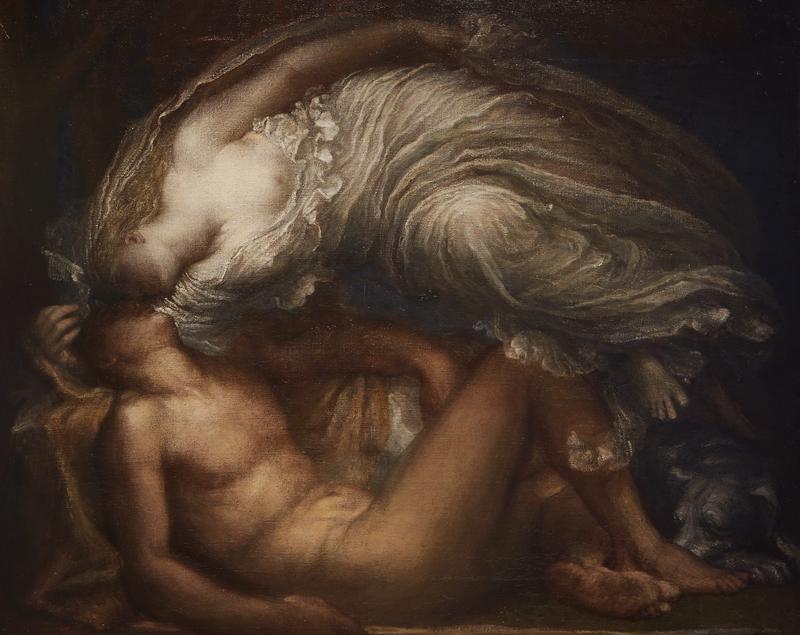Endymion

Recently Exhibited
Mitsubishi Ichigokan Museum, Tokyo, Japan, Parabola of Pre-Raphaelitism – Turner, Ruskin, Rossetti, Burne-Jones and Morris, March to June 2019Kurume City Art Museum, Japan, Parabola of Pre-Raphaelitism – Turner, Ruskin, Rossetti, Burne-Jones and Morris, June to September 2019
Abeno Harukas Art Museum, Osaka, Japan, Parabola of Pre-Raphaelitism – Turner, Ruskin, Rossetti, Burne-Jones and Morris, October to December 2019
Additional Exhibition History
London, International Exhibition, 1872, no. 445London, Grosvenor Gallery, 1881, no.56
London, Grosvenor Gallery, Collection of the Works of G.F. Watts, R.A., Winter Exhibition 1881-1882, no. 48
New York, Metropolitan Museum of Modern Art, Paintings by G.F. Watts, R.A., 1884-1885, no.120
Birmingham, Collection of Paintings by G. F. Watts, R.A., 1885, no.167
London, New Gallery, The Works of G.F. Watts, Winter Exhibition, 1896-1897, no 101
London, Royal Academy, George Frederick Watts, O.M., R.A., 1817-1904, 1954-5, no.58
Paris, Petit Palais, La Peinture Romantique Anglaise Les Préraphaélites, 1972, no.320
Rome, Galleria Nazionale, Arte Moderna, The Symbolism Exhibition, 2006
‘There is the most beautiful of all his pictures the Dream of Endymion…' Edward Coley Burne-Jones
In Greek mythology, Selene (the goddess of the moon who was sometimes regarded as the personification of the moon itself), is known for her affair with the beautiful mortal Endymion, the young shepherd who used to sleep on a mountaintop, and with whom she had fifty daughters. In Roman mythology, Diana has the attributes of Selene and a similar myth tells of her falling in love with Endymion. Both goddesses were regarded as lunar goddesses, although Diana became a virgin goddess of the moon, hunt and chastity. Besotted with the handsome Endymion, Diana would make nocturnal visits to kiss Endymion while he slept. She begged her father Jupiter to grant the mortal eternal youth so that he would never leave her. One night, Diana’s light-touch partly woke Endymion and he caught a brief glimpse of her. Incredulous at her beauty, he attributed it to a dream and began to prefer his dreamlike state to his daily life. Myths differ as to whether Diana’s love was unrequited.
Watts was home-schooled by his father and he studied classical literature such as the Iliad from youth. He would have known the myth of Endymion from classical sources such as Theocritus as well as from Keats’s poem Endymion. It was a subject popular from the Renaissance to the Romantics. The precocious Watts loved Ancient Greece and was apprenticed to the sculptor William Behnes from the age of ten. He studied and copied devotedly the hugely influential Parthenon marbles in the British Museum, about which he wrote, ‘It was from them alone that I learned’ and he described the draperies of the ancient statues or fragments as, ‘tremulous, palpitating beauty […] music of form, light and colour’. The figure of Endymion is suggestive of the statue of Dionysos on the marbles, who contemporaneously was believed to be Theseus.
Endymion was a subject that Watts was fascinated by for much of his career, creating three paintings of the theme. In 1893, he painted a vertical format of the subject (Watts Gallery) and in 1903 he painted a larger landscape painting, which was more visionary and looser in style (Watts Gallery). The present work and the 1903 Endymion both expand the figurative elements to command almost every inch of the canvas. According to Mary Seton Watts (George Frederick Watts, Vol.II, 1912, p. 313), ‘One morning I went in to find that in the early hours of the day Signor had taken up the canvas upon which in the late ‘sixties he had laid in an outline of his “Endymion”. The small version, so well-known by reproductions, sculpturesque and definite, he had decided to make this larger picture visionary and mystic, the moon goddess only luminously visible. When first I saw it, I exclaimed in surprise, “Oh, Signor, what a dream for him to have!” and he answered with a half-regretful smile, “Yes, but it was only moonshine after all.”’
In the present version, Watts illuminates Diana’s diaphanous draperies with dazzling light as she hovers intensely close to Endymion in the form of a crescent moon. Her luminescent lunar-whiteness is other-worldly and a dramatic juxtaposition is created with the human, earth-toned figure of Endymion. She is the spirit conquering matter beneath her. Her shocking, unearthly ethereal whiteness has crept down onto the sleeping dog who has become enthralled by her as she will overwhelm Endymion too. The image is not necessarily a comfortable one as Endymion lies limply under her, her hand reaches around his head as if she is pulling his head back to receive her. It is hard to tell if he is complicit in the communion. Diana appears as a breath – is she an out-breath, a sigh, a dream of Endymion’s, or is she taking his breath, taking or sucking the life-breath from Endymion?
As a reinvigoration of classical form, Renaissance painters had utilised the circle in their paintings to add focus, balance, logic and harmony. The circle was the most basic and important ideal geometric form and, as such represented the idea of perfection and unity and, thus, was seen as a compelling representation of the divine. Within the circle, figures and heads link, points of importance are highlighted, or spaces are created which are important to the geometry and balance of a painting. Watts incorporated the circle into many of his paintings; Richard Jefferies talked of Watts’s ‘harmony of design’ and especially his ‘theory of the linear curve’ whereby a series of minute opposite curves make up the central curve. In 1904, G. K. Chesterton (G. F. Watts, Chicago, p. 62) wrote of Watt’s ‘simple and powerful’ lines, being both ‘candid and austere’. He highlights Watts’s appreciation of the classical, stating ‘simply as a form of a picture, a mere scheme of lines, [is] the very soul of Greece’, and proselytizes that Watts’s curve, ‘suggests a feeling, a sense of fear, of simplicity, of something which lies near to the nature of the idea itself, the idea which inspires … It is simple; it is full and free; it follows great laws of harmony, but it follows them swiftly and at will; it is headlong, and yet at rest, like the solid arch of a waterfall. It is the rushing and passionate meeting of two superb human figures; and it is almost a mathematical harmony.’
The present work was Watts’s first version of the subject, begun in 1868 and completed over the next few years. It was much praised and exhibited widely and the intensity of the subject and its exceptional fine finish caught the eye of the prominent collector and Glasgow MP William Graham, who purchased it in 1872.



